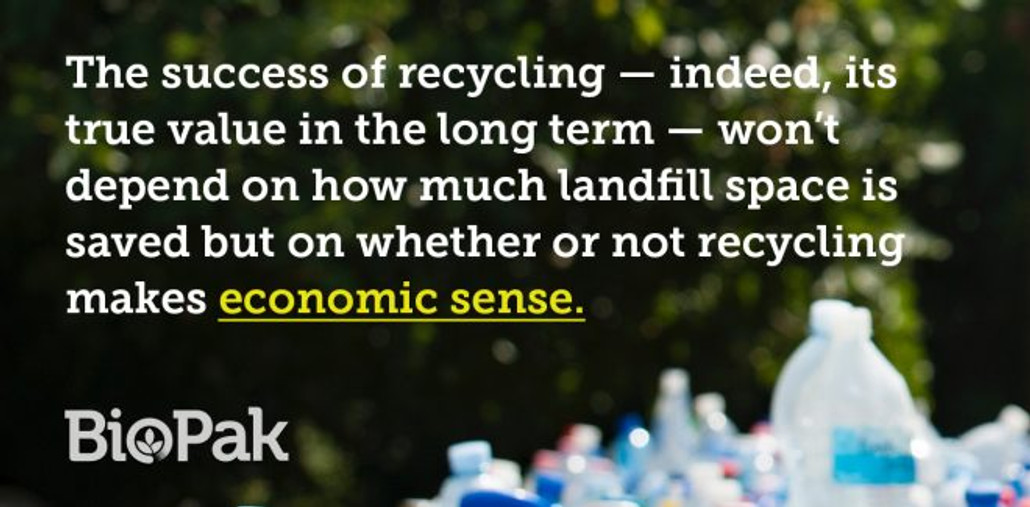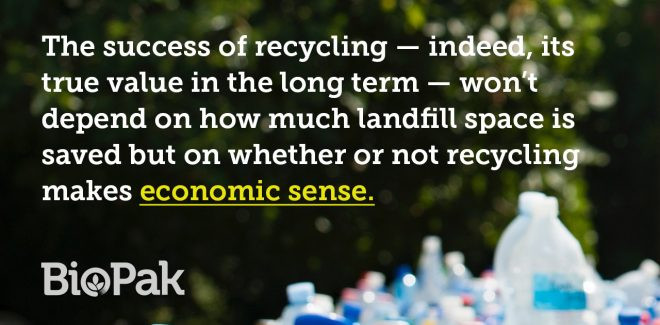
When Recycling Makes Cents
6th Jan 2020
While the percentage of waste to landfill has decreased, overall waste (including recycling) has increased due to the growing population. Although our percentage of total waste ending up in landfill has decreased, waste overall has increased due to the growing population. This means that recycling does not reduce waste created. Instead, it minimises lost resources by diverting material from landfill and transforming it into a new material. Sounds good, right? However, there are still two basic questions about recycling that we need to answer: is it actually good for the environment, and does it make sense economically?

Why recycle?
Recycling is generally desirable, but it is not automatically efficient and cheap. Recycling is generally desirable, but it is not automatically efficient and cheap. State-of-the-art single-stream recycling programs need a significant up-front capital investment, and the programs’ success depends on there being a market for the recycled materials. In this way, recycling is completely dependent on economics. Richard Fine, BioPak’s Founder and Sustainability Director, notes that we need to work together to find a new approach.
What is being done?
The takeaway coffee cup is the poster child of single-use packaging. Recently, corporations and entrepreneurs have taken steps to resolve Australia’s recycling crisis. While some proposed solutions appear to be viable, others are simply marketing ploys based on impractical models. As an example, let’s talk about the poster child of single-use waste – the takeaway coffee cup. Grassroots movements call for an outright ban, governments consider taxing their use, and multinationals commit funding to develop solutions; however, some companies have proposed specific solutions that focus only on takeaway cups.
And the problem with this model is … It would take 216 truckloads to transport all the coffee cups used in a year in Australia. Waste is transported long distances to be processed, whether it is being recycled or taken to landfill. One truckload can carry 6 million cups, which means we would need 216 truckloads per year to transport all the coffee cups used in Australia. There is limited logic to the idea of using fleets of fuel-hungry trucks that duplicate the route driven by garbage trucks to take one specific product to a reprocessing facility which is located large distances from the source of the waste. This would add significantly to the carbon footprint of the product. In addition, solutions such as these require additional funding or subsidies in order to remain commercially viable.
Our solution
Compostable packaging can be made from waste sugarcane pulp. This means it will break down during composting. The only solution which is commercially viable, will work for any suitable product, and can be implemented on large scales, is commercial composting. The technology to produce compostable cups is available to all cup manufacturers. Using compostable packaging is convenient and its collection process is simple and inexpensive. It diverts organic waste from landfill, and there is no need to sort food scraps from plastic items: just dispose of all food scraps and compostable packaging in one bin. The composting process can be done locally and there is demand for the end product: high quality compost. Recycling rates improves up to 25 per cent when consumers do not need to separate waste streams, according to research by Solid and Hazardous Waste Education Centre and the University of Wisconsin. This means that greater volumes of materials will end up out of landfill and contributing their resources to new products.
The problem
Compostable packaging can be broken down along with food scraps in processing facilities like this one. In many parts of Australia, the biggest obstacle to widespread composting is the lack of composting facilities, organics collection, and transportation infrastructure. Some businesses are actively working to remove these barriers and expand the availability of composting throughout the country.
BioPak Compost Service
The BioPak Compost Service is now available in 1300 suburbs across 9 major cities in Australia. The BioPak Compost Service is now available across 1300 suburbs in 9 major cities in Australia – diverting food scraps, organics, and certified compostable packaging from landfill. States and local councils are increasingly implementing organic waste recycling plans, which prevent food waste and other organics from being disposed of in landfills. These are often paired with public grant programs to spur investment in infrastructure. We must avoid unnecessary use of single-use food packaging made from fossil fuels, and instead look to compostable, plant-based plastics. Now is the time to adopt a sustainable packaging system that drives economic growth.
Information taken from this article on BioPak's blog. To read more about composting or a circular economy, check out our blog.
Planet Friendly Packaging acknowledges the traditional custodians of the land on which we work.

